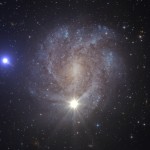W. M. Keck Observatory press release…
Scientists using the W. M. Keck Observatory and Pan-STARRS1 telescopes on Hawaii have discovered a star that breaks the galactic speed record, traveling with a velocity of about 1,200 kilometers per second or 2.7 million miles per hour. This velocity is so high, the star will escape the gravity of our galaxy. In contrast to the other known unbound stars, the team showed that this compact star was ejected from an extremely tight binary by a thermonuclear supernova explosion. These results will be published in the March 6 issue of Science.

A close encounter with the supermassive black hole at the centre of the Milky Way is typically presumed the most plausible mechanism for kicking these stars out of the galaxy.
A team of astronomers led by Stephan Geier (European Southern Observatory, Garching) observed the known high-velocity star know as US 708 with the Echellette Spectrograph and Imager instrument on the 10-meter, Keck II telescope to measure its distance and velocity along our line of sight. By carefully combining position measurements from digital archives with newer positions measured from images taken during the course of the Pan-STARRS1 survey, they were able to derive the tangential component of the star’s velocity (across our line of sight).
Putting the measurements together, the team determined the star is moving at about 1,200 kilometers per second – much higher than the velocities of previously known stars in the Milky Way galaxy. More importantly, the trajectory of US 708 means the supermassive black hole at the galactic center could not be the source of US 708’s extreme velocity.
US 708 has another peculiar property in marked contrast to other hypervelocity stars: it is a rapidly rotating, compact helium star likely formed by interaction with a close companion. Thus, US 708 could have originally resided in an ultra compact binary system, transferring helium to a massive white dwarf companion, ultimately triggering a thermonuclear explosion of a type Ia supernova. In this scenario, the surviving companion, i.e. US 708, was violently ejected from the disrupted binary as a result, and is now travelling with extreme velocity.
These results provide observational evidence of a link between helium stars and thermonuclear supernovae, and is a step towards understanding the progenitor systems of these mysterious explosions.

